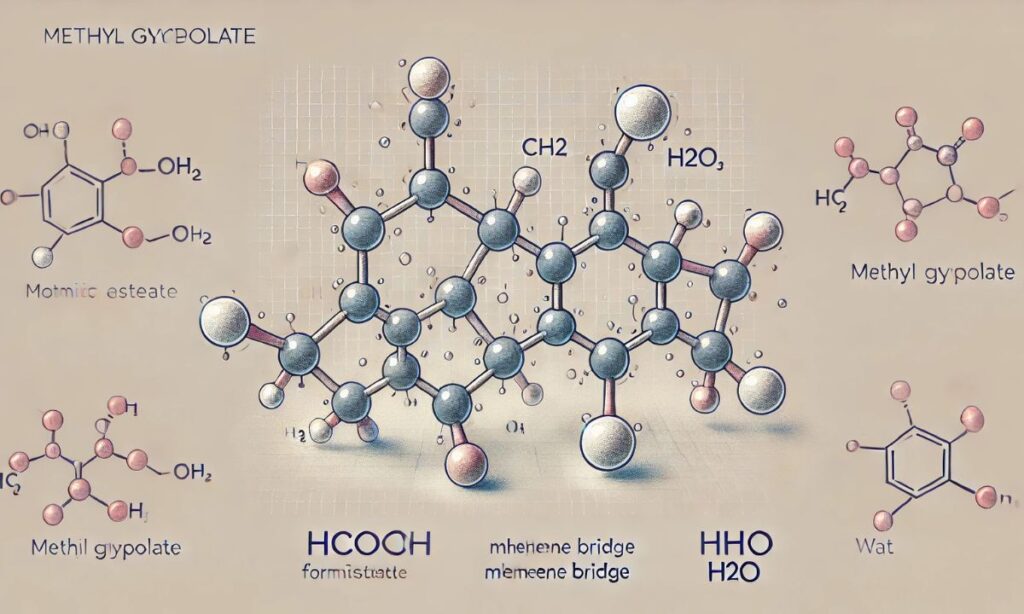Introduction
HCOOCH CH2 H2O, or methyl glycolate, is an organic compound with a unique structure crucial in organic chemistry. The compound contains a formic acid ester (HCOOCH), methylene bridge (CH2), and a water molecule (H2O), enhancing reactivity. Methyl glycolate is valuable in academic and industrial settings because it can participate in various chemical reactions.
The compound’s importance in organic chemistry lies in its ability to act as a reactant and solvent, facilitating multiple transformations in organic synthesis. Its functional groups enable chemists to fine-tune reaction conditions for better yields and selectivity. Throughout this blog, we will explore methyl glycolate’s molecular structure, its key components’ role, its chemical properties, and how these characteristics contribute to its applications in pharmaceuticals, fine chemicals, and industrial processes. By understanding its composition and behavior, we can better appreciate the compound’s significance in advancing organic chemistry.
Molecular Structure and Composition of HCOOCH CH2 H2O
HCOOCH (Formic Acid Ester)
The formic acid ester group (HCOOCH) is a vital component of methyl glycolate. This ester consists of a carbonyl group (C=O) bonded to an oxygen atom, which is further attached to a methyl group (CH3). The ester group imparts high reactivity to the molecule, enabling it to participate in diverse chemical reactions such as esterification, nucleophilic substitution, and hydrolysis. It is a reactive site, facilitating bonding with other molecules, and is crucial in synthesizing various organic compounds.
CH2 (Methylene Group)
The methylene group (CH2) acts as a bridge connecting the ester and water components in the molecule. This two-carbon structure influences the overall shape and flexibility of methyl glycolate. It plays a key role in the molecule’s reactivity, allowing the compound to adopt different conformations, which can impact how it interacts with other molecules. The methylene group’s position and bonding flexibility enhances the molecule’s reactivity, making it highly adaptable to various chemical processes.
H2O (Water Molecule)
The presence of a water molecule in the structure of methyl glycolate enhances its solubility in polar solvents, making it easier to dissolve and interact with other substances. Additionally, water facilitates hydrogen bonding, which further influences the compound’s reactivity. These hydrogen bonds can affect the rate and selectivity of chemical reactions, making methyl glycolate an effective participant in many organic transformations. The water molecule not only aids in solubility but also plays a significant role in modulating the compound’s behavior in chemical processes.
Chemical Properties
Polarity
The hydroxyl group in methyl glycolate contributes to its polarity, making it highly soluble in water and other polar solvents. This polarity enhances its ability to interact with other polar molecules, essential in many organic reactions. The presence of the hydroxyl group allows for hydrogen bonding, further influencing the compound’s solubility and reactivity. The ability to dissolve in polar solvents is key in its use as a reagent and solvent in various chemical processes.
Thermal Stability
Methyl glycolate exhibits moderate thermal stability, allowing it to withstand elevated temperatures without decomposing. This property is significant for industrial applications, where reactions often occur at high temperatures. The compound’s thermal stability ensures it can be used effectively in large-scale chemical processes without substantial degradation, making it a reliable component in synthetic pathways.
Reactivity
The carboxylate moiety in methyl glycolate displays dual-acid/base behavior, depending on the conditions it is subjected to. This property allows the compound to participate in various reactions in acidic and basic environments, such as ester hydrolysis or nucleophilic substitution. Additionally, the hydrogen bonds the water molecule forms can influence reaction pathways, modulating reaction rates, and selectivity during synthesis.
Role in Organic Synthesis
Reagent and Solvent
Methyl glycolate serves a dual purpose as a reagent and a solvent in organic reactions. As a reagent, it is involved in various chemical transformations, providing a reactive site for bonding with other molecules. As a solvent, it helps dissolve reactants, facilitating smoother reactions and improving efficiency. This versatility makes it indispensable in many synthetic processes.
Starting Material
In organic synthesis, methyl glycolate is frequently used as a precursor for producing more complex molecules, especially in the pharmaceutical and fine chemicals industries. Its functional groups allow it to be converted into various compounds, including drugs and specialty chemicals. This makes it an essential building block in creating new, bioactive molecules and advanced materials.
Reaction Modulation
The presence of functional groups in methyl glycolate allows chemists to modulate reaction conditions for better yields and selectivity. By adjusting factors like solvent polarity, temperature, and concentration, methyl glycolate can help fine-tune reactions, optimizing the overall process. Its role in reaction modulation is crucial for improving the efficiency and outcomes of complex organic syntheses.
Applications
Pharmaceuticals
Methyl glycolate is widely used as an intermediate in synthesizing pharmaceutical compounds. Its reactive ester group is an ideal precursor for creating bioactive molecules, including drugs targeting various medical conditions. The compound’s versatility allows chemists to modify its structure to generate a range of therapeutic agents. Its role in drug synthesis is essential for developing new treatments, particularly in producing specialized medications with precise molecular characteristics.
Fine Chemicals
Methyl glycolate is a critical building block for synthesizing specialized chemicals with high precision in producing fine chemicals. Its functional groups enable chemists to control reaction pathways and achieve the desired chemical structures. This makes it particularly valuable in creating complex compounds in various industries, from agriculture to electronics, requiring fine-tuned chemical properties.
Industrial Processes
Methyl glycolate’s stability and reactivity make it valuable in large-scale chemical manufacturing. Its ability to withstand heat and engage in various reactions under different conditions makes it suitable for industrial processes where efficiency and reliability are key. The compound synthesizes numerous chemicals and materials, supporting the development of products integral to many industries, such as polymers, coatings, and fragrances.
Conclusion
Scientists recognize methyl glycolate (HCOOCH CH2 H2O) as an essential compound in organic chemistry due to its unique molecular structure and versatile properties. Its combination of a reactive ester group, a methylene bridge, and a water molecule allows it to participate in various chemical reactions. The compound’s importance spans industries, from pharmaceuticals and fine chemicals to large-scale industrial processes. As a reagent, solvent, and starting material, methyl glycolate plays a pivotal role in synthesizing complex molecules and developing new materials. Its broad applications demonstrate its significance in advancing scientific research and industrial manufacturing.




The website design looks great—clean, user-friendly, and visually appealing! It definitely has the potential to attract more visitors. Maybe adding even more engaging content (like interactive posts, videos, or expert insights) could take it to the next level. Keep up the good work!
The website design looks great—clean, user-friendly, and visually appealing! It definitely has the potential to attract more visitors. Maybe adding even more engaging content (like interactive posts, videos, or expert insights) could take it to the next level. Keep up the good work!
djitrdkuwvdeotrqmgyzgtmjfmhljl